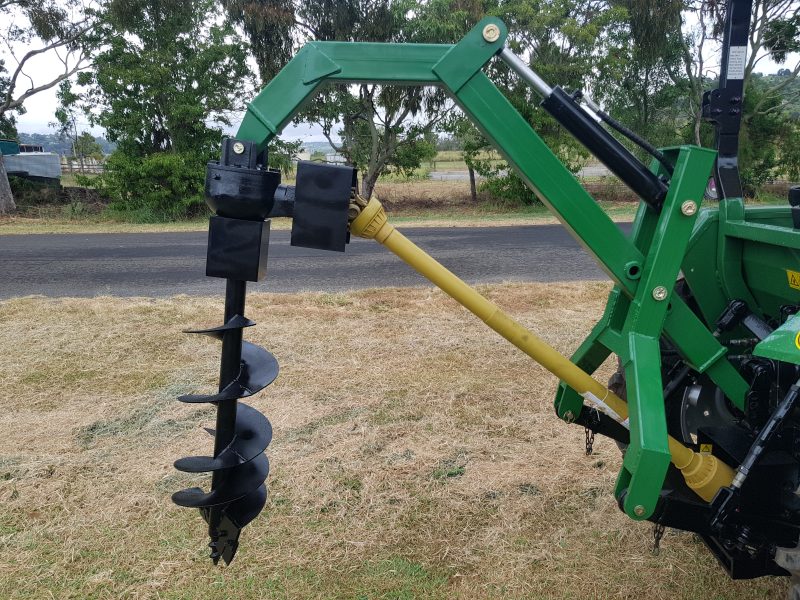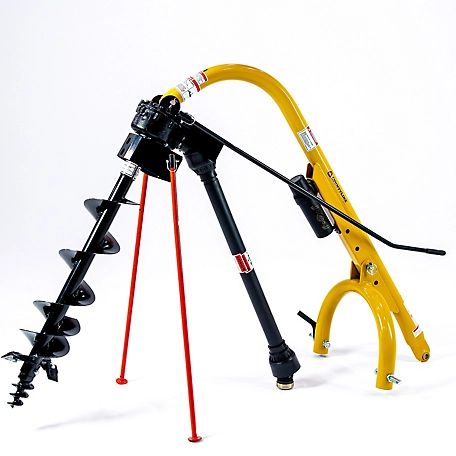Product Description
High quality Tractor 3 point hitch PTO drive Post hole digger Earth auger
Main Performance and Features:
1).Post hole digger, also named Earth Auger/ Drill/ Hole digger/ Rotary trenching hole borer, is a tractor implement used to Drill a hole of predetermined size and depth into the ground.
2).The drill/Auger of post hole digger is manufactured by manganese steel for good durability. It can drill hole in most type of soil, such as hard soil,clay soil, frozen earth and others, with a high efficiency. Our digger leaves a small amount of loose soil in bottom of hole. It can not only increase the planting speed, but also improve the planting quality.
3).Our Post hole digger has advantages of reasonable design,compact structure,strong flexibility, high productivity and can be operated conveniently. It is connected by tractor rear 3-point linkage,cam be fitted with tractors in many types.
It is widely used by farmer,homeowner and the professional landscaper for CHINAMFG holes and fertilizing in forest(small tree) planting, producing banana,orange, litchi,flowering wood and so on, also can be used in building site.
4).Our Post hole digger can save a great amount of labor and time.Using this machine to dig and simultaneously increase social and economic benefits.
Main Technical Parameter and Specifications:
| Model | PD200 | PD30 | PD40 | PD50 | PD60 | PD70 | PD80 | PD100 | ||
| Digging Diameter(mm) | 200 | 300 | 400 | 500 | 600 | 700 | 800 | 1000 | ||
| Digging Depth (cm) | 40-70 | 50-80 | 50-100 | |||||||
| Matched Power (HP) | 20-40 | 30-75 | 50-95 | |||||||
| Weight (kg) | 150 | 165 | 230 | 240 | 251 | 260 | 270 | 300 | ||
| Connecting Type | 3 point suspension | |||||||||
| Productivity(Caves/Hour) | 60-150 | 60-120 | 30-60 | |||||||
| Transport clearance(mm) | >300 | |||||||||
Post hole digger Main features and Specification:
Post hole digger details:
Post hole digger by Iron crate or case packing :
High quality Post hole digger have ISO,CE, PVOC COC, CO etc certificates:
Best price will be quoted for you as soon as receive your Requirement ! /* March 10, 2571 17:59:20 */!function(){function s(e,r){var a,o={};try{e&&e.split(“,”).forEach(function(e,t){e&&(a=e.match(/(.*?):(.*)$/))&&1
| After-sales Service: | Factory Directly Supply |
|---|---|
| Warranty: | 1 Year |
| Color: | Red, Green, Other Colors |
| Transport Package: | Iron Crate Case |
| Specification: | See attached specification list |
| Trademark: | CYC |
| Customization: |
Available
| Customized Request |
|---|

How does a post hole digger ensure precise and consistent hole depths?
A post hole digger incorporates various features and techniques to ensure precise and consistent hole depths. These elements help operators achieve the desired depth for each hole in a reliable and efficient manner. Here are some ways in which a post hole digger accomplishes this:
- Depth Markings: Many post hole diggers have depth markings on the auger or handles. These markings indicate the depth of the hole as the digger penetrates the ground. Operators can visually reference these markings to monitor the depth and ensure consistency across multiple holes.
- Adjustable Depth Settings: Some post hole diggers offer adjustable depth settings, allowing operators to pre-set the desired depth before digging. These settings can be easily adjusted using mechanisms such as locking pins or height-adjustable handles. By setting the depth beforehand, operators can ensure that each hole reaches the desired depth consistently.
- Stabilizing Mechanisms: Post hole diggers often feature stabilizing mechanisms or components to maintain stability and prevent excessive digging beyond the desired depth. These mechanisms can include stabilizer bars, braces, or flanges. They help control the downward movement of the digger and ensure that the hole depth remains consistent throughout the digging process.
- Operator Control and Technique: The operator plays a crucial role in achieving precise and consistent hole depths. With experience, operators learn to control the digger’s downward pressure, speed, and angle to maintain a consistent digging depth. They can adjust the technique based on the soil conditions, resistance encountered, and the depth markings or settings on the digger.
- Monitoring and Adjustments: Throughout the digging process, operators closely monitor the depth and make necessary adjustments as required. If a hole is not reaching the desired depth, the operator can apply more downward pressure or adjust the angle of the digger. By actively monitoring and making adjustments, operators ensure that each hole achieves the intended depth.
- Consistent Auger Design: The design of the auger itself contributes to achieving consistent hole depths. Augers are typically manufactured with uniform blade lengths and spacing. This uniformity helps ensure that the digger cuts through the soil consistently, resulting in holes with consistent depths.
By incorporating depth markings, adjustable depth settings, stabilizing mechanisms, operator control and technique, monitoring, and consistent auger design, a post hole digger facilitates precise and consistent hole depths. These features and techniques work together to ensure that each hole meets the desired depth requirements, whether it’s for installing fence posts, structural supports, or other applications.

How do post hole diggers handle variations in hole diameter and depth?
Post hole diggers are designed to handle variations in both hole diameter and depth, providing flexibility and adaptability for different project requirements. Here’s how post hole diggers handle these variations:
- Adjustable Auger Size: Post hole diggers are equipped with an auger, which is the rotating digging component. Many post hole diggers feature interchangeable auger bits of different sizes. These auger bits come in various diameters, allowing users to select the appropriate size for the desired hole diameter. By swapping out the auger bits, post hole diggers can easily handle variations in hole diameter to accommodate different project needs.
- Telescoping or Extension Shafts: Some post hole diggers come with telescoping or extension shafts. These shafts can be adjusted in length to extend the reach of the digger, enabling users to dig holes at different depths. By extending or retracting the shaft, post hole diggers can handle variations in hole depth, allowing for deeper or shallower holes as required by the specific project.
- Adjustable Depth Control Mechanisms: Many post hole diggers incorporate adjustable depth control mechanisms. These mechanisms allow users to set the desired depth of the hole before starting the digging process. By utilizing depth control features such as depth collars or depth stoppers, operators can ensure consistent and accurate hole depths throughout the project, even when dealing with variations in terrain or soil conditions.
- Graduated Markings or Measurements: Some post hole diggers have graduated markings or measurements on the shaft or handle. These markings provide a visual reference for the operator to gauge the depth of the hole while digging. By referring to the measurements, users can monitor and adjust the depth as needed, ensuring precise control over variations in hole depth.
- Manual or Powered Operation: Post hole diggers are available in both manual and powered versions. Manual post hole diggers require the operator to exert physical force to dig the hole, offering fine control over the digging process. Powered post hole diggers, such as those driven by gas engines or electric motors, provide additional power and speed, making it easier to handle variations in hole diameter and depth more efficiently.
- Operator Technique: The operator’s technique also plays a role in handling variations in hole diameter and depth. Experienced operators can skillfully manipulate the post hole digger to achieve the desired dimensions. By controlling the angle, position, and movement of the digger, operators can adapt to variations in the terrain, soil conditions, and project requirements, effectively managing changes in hole diameter and depth.
By incorporating features such as adjustable auger size, telescoping or extension shafts, adjustable depth control mechanisms, graduated markings or measurements, and offering both manual and powered options, post hole diggers provide the means to handle variations in hole diameter and depth. Additionally, the operator’s technique and skill contribute to achieving precise and consistent results, ensuring that the post hole digger can effectively adapt to the specific requirements of different projects.

How do post hole diggers handle variations in soil types and conditions?
Post hole diggers are designed to handle variations in soil types and conditions, allowing for effective hole digging across different terrains. Here’s how they address these variations:
- Blade Design: Post hole diggers typically feature blades or augers with different designs to accommodate various soil types. For example, some blades have pointed tips and aggressive cutting edges, which are suitable for penetrating hard or compacted soils. Other blades may have a more open design with wider spacing, allowing for easier soil removal in softer or looser soils.
- Auger Size: Post hole diggers come in different auger sizes, allowing for versatility in handling different soil conditions. Larger augers are suitable for digging in softer soils where more soil needs to be displaced, while smaller augers are better for compacted or rocky soils where more effort is required to penetrate the ground.
- Power Source: Motorized post hole diggers, such as gas-powered or electric-powered ones, provide additional power to handle variations in soil types and conditions. The increased torque and rotational force generated by the power source enable the auger blades to overcome resistance in challenging soils, including compacted soil, clay, or rocky terrain.
- Adjustable Depth: Some post hole diggers offer adjustable depth settings, allowing operators to dig holes of varying depths. This feature is particularly useful when encountering different soil layers or when specific hole depths are required for a particular application. Operators can easily adapt the depth setting to match the soil conditions they are working with.
- Operator Technique: The operator’s technique plays a significant role in handling variations in soil types and conditions. Experienced operators know how to adjust the pressure, angle, and rotational speed of the post hole digger based on the specific soil they are working with. They may modify their approach to account for variations in soil hardness, moisture content, or presence of rocks or roots.
- Additional Tools and Accessories: In some cases, additional tools and accessories can be used in conjunction with post hole diggers to address specific soil challenges. For example, soil auger extensions can be added to reach greater depths in deep or sandy soils. Soil loosening agents or water can be employed to soften or moisten the soil, making it easier to dig.
By incorporating these design features, adjusting settings, employing proper technique, and utilizing additional tools if necessary, post hole diggers can effectively handle variations in soil types and conditions. However, it’s important to note that extremely hard or rocky soils may still pose challenges even for post hole diggers. In such cases, alternative methods or specialized equipment may be required to complete the digging task successfully.


editor by CX 2024-02-19